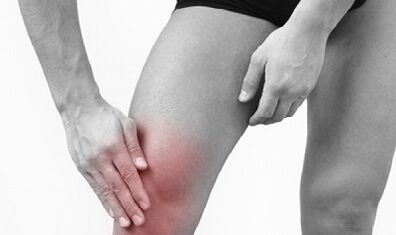
One of the most common pathology of the musculoskeletal system is arthritis in the knee joint (otherwise gonadotropism) is a chronic disease with malnutrition and damage to the knee joint structure.
The result of a destructive process is a sharp limit or complete loss of joint mobility, and the result - performance reduction, disability.
Adverse consequences can only be prevented when diagnosed and treated in a timely manner.
reason
It originates from the knee joint, which is primary and secondary.The main development is a separate disease that is more common in the diagnosis in older people, in which case it occurs in tissues due to age-related changes.Secondary adenotropic cancer becomes the result of other diseases and diseases in the body.
The development of adenotropic cancer helps:
- Injury (dislocation, fracture, meniscus injury);
- Diseases of the musculoskeletal system (congenital deformation of the legs, knee dysplasia, calcification of the cartilage, arthritis, osteoporosis);
- Due to professional activities, professional sports, the continuous high load of joints;
- Overweight, obese;
- Endocrine diseases, including diabetes, hypothyroidism, Yachengti;
- Metabolic disorders;
- Genetic tendency.
symptom
Inflammation of knee arthritis is accompanied by two major clinical manifestations - pain and edema.The intensity and frequency of pain occurring depends on the depth of damage to the joint structure.In the initial stage, pain can only be felt through the load, and stillness will pass quickly.With the effects of advanced adenotropic cancer, the pain persists, intensifies during exercise, and changes in weather.
Other signs of knee arthritis:
- Tighten when moving;
- The stiffness of the joint violates the motor function;
- Deformation of the knee (neglected companion).
Advotropic inflammation can be accompanied by synovitis (abundance of fluid in the joint cavity) and subsequent formation of bread cysts (elastic formation on the back of the knee).
Articulation degree
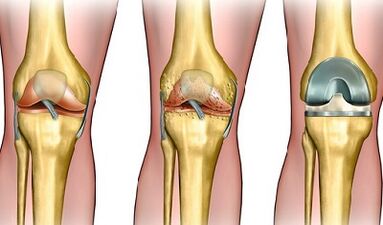
The symptoms of knee joints depend on the depth of damage to the knee structure, thus distinguishing between 3 stages of pathology.
- 1 degree articulation of knee jointIt manifests as soreness under load (at one time of rest), with a slight stiffness after sleep.In the radiographic picture, the insignificant (less than one-third) narrowness of the joint space is noted for the presence of monoblastic plants (bone birth).
- 2 degrees of knee jointIt is accompanied by pain and characteristic tightening during exercise.The pain lasted for a while.Note the stiffness in the morning, limiting the amplitude of the movement.Diagnostic procedures revealed significant narrowing of joint space (more than half) and multiple bone plants.
- Knee joint 3 degreesIt comes with persistent pain, which can be exacerbated during exercise and at night.During the remission period, inflammation worsened, at least half an hour, and the morning stiffness remained for an hour.The mobility of the joints is dramatically limited or completely lost.In the radiographic picture, multiple large bone plants can be seen and cysts can be seen.The range of joint space has been reduced by more than two-thirds.
The patient is prescribed conservative or surgical treatment based on the degree of joint nature of the knee joint.
diagnosis
Diagnosis of knee joints and joints includes visual examinations, analysis of patient complaints, laboratory examinations (urinary analysis, general and biochemical blood tests) and tool examination methods.
The following diagnostic procedures allow you to confirm or refute the diagnosis:
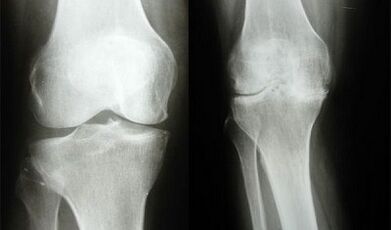
- Radiography;
- Ultrasound (ultrasound);
- MRI (magnetic resonance imaging);
- CT (Computed Tomography);
- Arthroscopy and scintillation diagram (tumour suspected).
Using these methods, the stenosis of the joint space, the degree of thinning and deformation of the cartilage, the presence of fluid in the joint cavity, structural changes of the synovial membrane, the growth of the osteosoftening membrane and the focus of cartilage ossification can be detected.
Conservative treatment
Conservative treatments can reduce pain and inflammation, improve blood circulation and nutrition, and strengthen muscle equipment.
For this purpose, they are considered:
- Drug treatment;
- blockade;
- Physical therapy and manual therapy;
- Medical Sports.
An important part of joint therapy is adherence to a therapeutic diet.
Conservative treatment of knee joints will be effective in the initial stages of the disease when secondary malnutrition cartridges are noted with small cartilage, inflammation and impaired synovial shell function.
poison
Medication treatment includes appointments:
- nonsteroid anti-inflammatory drugs (NSAIDS);
- Cartilage protectant;
- Hyaluronic acid.
NSAID
Nonsteroid anti-inflammatory drugs help relieve inflammation and reduce its main symptoms - edema and pain.
The preparation is prescribed in the form of a solution (for intramuscular administration) or in the form of a tablet, capsule (for oral administration).Capsules and tablets for knee joints in the NSAID group are taken in a short period of time because these drugs have a strong irritating effect on the gastric mucosa and can cause the development of peptic ulcers, thus having many other side effects.
Additionally, prescribed external medications (oints, gels, creams) based on non-replacement anti-inflammatory ingredients.Allows the topical therapy to be performed for longer periods of time.
NSAID has obvious anti-inflammatory effects, but long-term use can help further damage the cartilage.
NSAID is a symptomatic treatment.They help eliminate unpleasant symptoms of the disease, but do not affect the condition of the cartilage.In contrast to these products, cartilage protectors and hyaluronic acid accelerate the process of cartilage tissue regeneration and slow down its damage.
Cartilage protector
The medications in the cartilage protector group contain chondroitin and glucosamine (structural cartilage element) and help restore the knee through knee arthritis.They are used in the form of tablets, powders for oral administration, a kind of injection solution.
The minimum route to taking tablets and powders is 3 months.After rest, repeat the course 2-3 times.The treatment process with the solution consists of 12-15 injections, repeated 2-3 times a year.
The first positive outcome of treatment with cartilage protectors is worth noting after several months after treatment begins.
Hyaluronic acid
Hyaluronic acid is introduced into the affected joint.The articular healing of knee joints plays a lubrication role - wrapping the joint surface, thus reducing friction between them.
Hyaluronic acid therapeutic drugs help increase the elasticity of cartilage tissue, prevent further damage to joint structure, thereby improving joint mobility and reducing symptoms of inflammation.The drug is well tolerated and will not cause side effects.Their only disadvantage is their high cost.
The treatment process of hyaluronic acid usually involves 3-4 injections, which are 10-14 days.
blockade
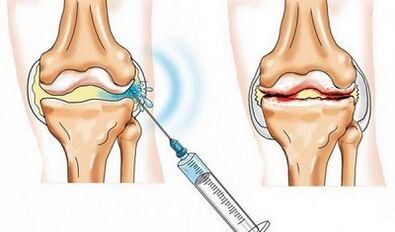
If non-steroidal anti-inflammatory drugs are used, knee pain in arthritis cannot be relieved and lockdown will be performed - a treatment in which the drug is injected directly into the affected tissue to relieve pain and inflammation.In the treatment of arthritis, obstruction of the joint (injection in the joint cavity) and surrounding (entering the peripheral cavity) is used.
The main advantage of this method is its immediate and purposeful effect, because using this introduction, the maximum concentration of active substances is precisely created in the inflammatory zone.In addition, the drug will not fall into the systemic blood, which greatly reduces the risk of adverse reactions.
In the late stage of gonadotropic tumors, joint space is narrowed, bone plant growth, joint surface deformation, and therefore only upper closure blockade is allowed.
Anesthetics and corticosteroids can be used to close the knee joint.
Anesthetics are often introduced in combination with steroid hormones to relieve pain from surgery.
Hyaluronic acid and cartilage protectors can also be introduced directly into the joints.But in this case, we are not talking about lockdown, but about joint injections, because these drugs do not stop the pain impulse, but trigger the process of regeneration of cartilage tissue.
Physical therapy and manual therapy
The main methods used to treat the physical therapeutic effects of joints include:
- laser therapy;
- Ultrasound therapy;
- cryotherapy;
- Treated with paraffin and Ozokerite;
- mud.
The main task of all physical therapy procedures is to stimulate blood circulation in nearby tissues and improve the nutrition of cartilage.
Exercise therapy
Pain syndrome forces patients with anorticitis to limit their motor activity, and therefore nearby ligaments and muscles are atrophy.This condition can negatively affect joint tissue because nutrients penetrate the cartilage from the synovial fluid during exercise.If the joints keep stationary, the malnutrition process will worsen.
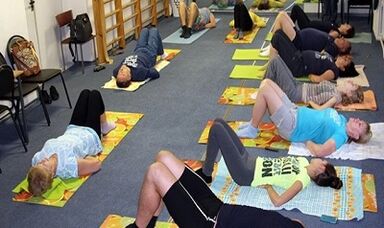
This is why physical therapy exercise is an integral part of conservative therapy.Moderate physical exercise allows you to strengthen muscle equipment, strengthen the strength of joint structures, eliminate stiffness and improve the knee’s motor function.
Taking into account the depth of the lesion and the functional status of the joint structure, the doctor developed movements for each patient separately.
General recommendations for knee joint articulation therapy:
- Start the course only after stopping the signs of acute inflammation;
- Perform all exercises smoothly without sudden movements;
- The load gradually increases;
- Eliminate high load on joints (strength/stretching of knees);
- If pain or discomfort occurs, stop training.
diet
Accompanied adenotropic cancer, including: Included products:
- Amino acids (dairy products, low-fat meat);
- Collagen (dish with gelatin);
- Irreversible fatty acids (vegetable oils, fish);
- Sulfur and selenium (beans, cereals, cabbage and apples, beef, chicken, eggs).
This is also very important:
- Eliminate the use of smoked meat, pickles, and marinades;
- Limit salt consumption;
- Follow 5 times the diet;
- Observe drinking patterns.
Excessive weight is one of the main factors that cause joint development of the knee joint.Therefore, the task of overweight patients reduces weight.In this case, you can only achieve results with the help of diet, as strengthening exercise is harmful to inflamed joints.
To lose weight, it is recommended to exclude from the menu:
- fat variants of meat and fish;
- Cream, homemade sour cream and other cream products, high in fat;
- Margarine, mayonnaise, various seasonings;
- candy;
- fast food;
- Sweet drink.
Surgical treatment
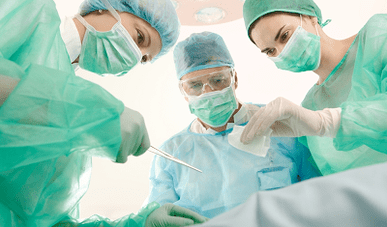
The 3-degree knee joint articulation is not suitable for conservative treatment, so this surgery is the only way out for patients.
There are two options for surgical intervention:
- Corrective osteotomy- It is carried out in the initial stage of stage 3 antral tropicitis, and if the cartilage is partially damaged, the genus of the bone can be removed;
- Opthetics- By completely destroying the cartilage, replacement of joints or their damaged parts is performed.
forecast
The pathological changes in joint structure are gradual and irreversible.However, with early diagnosis and proper treatment, you can completely stop inflammation and prevent malnutritional changes in cartilage tissues - Arthritis in the primary knee joint can be well suited for conservative treatment.
In joints at the secondary level, accompanied by the destruction of cartilage and the formation of bone plants, the conservative approach allows you to slow down or pause the deformation of cartilage, stop inflammation and improve motor activity.However, doctors are often forced to resort to arthroscopy.
It is impossible to cure 3 degrees of knee joint arthritis in a conservative manner.The only way to restore knee mobility is surgical intervention.
























